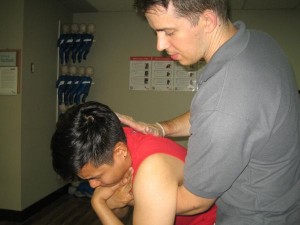
First aiders respond to countless cases of airway obstruction, such as choking, strangulation and suffocation, every year.Prompt and proper first aid is very helpful in preventing deaths due to airway obstruction.
A conscious patient suffering from airway obstruction will normally report or indicate problems with airway. This will give you clue as to the patient’s condition and be able to provide immediate first aid. However, if the person is unconscious or is unable to communicate, you will need to rely on your knowledge of signs and symptoms of airway obstruction. Many cases of airway obstructions are caused by the tongue dropping down the throat. Make sure to take appropriate measures to keep the airway patent.
Once the airway is open, you can perform techniques for correcting airway obstructions. These include finger sweeps and manual thrusts. In most cases, you will have to use both maneuvers.
When providing first aid for an unconscious patient, you should not delay opening the airway and checking breathing. Do not waste time looking for an airway obstruction if the patient is not breathing. Provide initial ventilations right away. If there is an obstruction, you will feel resistance as you blow air in and the chest does not rise. However, if there is no obstruction, the air should flow freely towards the lungs.
The maneuvers used in clearing airway obstruction depend on whether the patient is conscious, unconscious or has lost consciousness. Here is an overview of the techniques to be used for different patients.
Conscious adult patient – Initially, you should encourage the patient to cough and try to expel the obstruction. If this does not work, use abdominal thrusts: six to ten abdominal thrusts in rapid succession. This maneuver should be repeated until the obstruction is expelled or the victim losses consciousness.
Adult patient loses consciousness – Open the mouth and use finger sweep. If this is ineffective, provide ventilation. If this still fails, use abdominal thrust. After providing six to ten thrusts; open the mouth and use finger sweep. Repeat this process until the airway obstruction is dislodged.
Unconscious adult patient –Place the patient on his back. Attempt to give initial two ventilations. If this is ineffective, provide size to ten abdominal thrusts. Use finger sweep to remove the foreign object. Repeat this process until you are successful.
If you are still unable to dislodge the obstruction, you need to transport the patient to the nearest medical facility for more advanced emergency care.
Children – Abdominal thrusts are not recommended for children. Instead, use back blows for very young children (below 1 years of age). Use the heel of the hand to deliver four sharp blows in rapid succession. The child should be put in a face-down position, resting on your forearm, with the head lower than the body. Do not use blind finger sweeps or probes on infants and children.